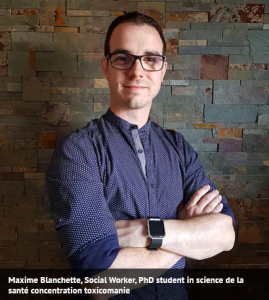What is sexualized drug use?
Sexualized drug use is defined as intentionally using psychoactive substances before or during sexual activity to prolong and/or intensify the experience, diversify practices or even improve sexual performance. Various substances can be used: alcohol, cannabis, cocaine…
It is all a question of intent. In fact, it is considered sexualized drug use when, for example, a person drinks enough alcohol to reach a desired state of inebriation to engage in sexual activity. This situation is different from the person who is drinking with friends at a bar, meets someone and then goes home with them. In both cases, sex happens under the influence of alcohol. However, the original intent was not the same.
Sexualized drug use has many objectives:
- to become uninhibited,
- to increase self-confidence,
- to decrease anxiety related to body image,
- to increase libido,
- to increase endurance,
- etc.
Thus, using drugs can enable some people to have the sexual relations they want to have by freeing themselves from different social pressures related to sex, such as, the “sexual performance” or “perfect body” cults. Pressures that are more prevalent in certain communities.
An over-representation of gay and bisexual men
“Gay and bisexual men use more drugs than their heterosexual counterparts.” (translated from French), states the article Trajectoires addictives et vécu homosexuel published in 2018 in Drogues, santé et société by researchers Jorge Flores-Aranda from Institut universitaire sur les dépendances and Karine Bertrand and Élise Roy from Université de Sherbrooke. Several factors can in fact, encourage the use of psychoactive substances among sexual minorities, namely:
- difficulty accepting one’s sexual orientation
- social stigmatization of sexual minorities
These characteristics unique to sexual minorities can also push them to seek refuge within the gay community, where, according to the study, “certain spaces for sexual socialization such as gay saunas and raves are described [by participants] as being conducive to drug use and the discovery of new substances.” (p.39)
A willingness to explore, self-discovery, social stigmatization, building social circles based on drug use and easy access to substances are all reasons that can also foster sexualized drug use among gay and bisexual men.
Chemsex: a form of sexualized drug use
It is all in the name: the term chemsex is made up of the words “chemical” and “sex”. Chemsex was conceptualized in the 2010’s by British activist and Social Worker David Stuart, who gives the following definition:
““Chemsex” is a term that describes a uniquely gay cultural phenomenon, also known as “Party ‘n Play” culture (PnP) or H&H culture (“High & Horny”). […] Chemsex is the use of any combination of drugs that includes crystal methamphetamine, mephedrone (and other cathenones) and/or GHB/GBL -specifically for the purposes of gay sex.”
According to David Stuart, chemsex is a phenomenon exclusive to gay culture due to different factors that are unique to it. He explains that within the gay community, pleasure associated with sex had been mainly ruined by:
- trauma and stigmatization related to HIV/AIDS
- societal, cultural and religious behaviours that contributed to the rejection or even disgust of gay sexuality
- a rejection culture unique to the gay community, exacerbated by the emergence of dating apps focusing on «marketing» one’s self through various affiliation criteria to sub-groups, body perfection, ethnic origins or even sexual performance.
- the systematic association of risk with gay sex
All these factors can therefore contribute to the chemsex experience. The use of drugs meets the need to be sexually freer, rid of the inhibiting factors mentioned above. Other than chemsex, these factors can also lead to sexualized drug use described earlier.

